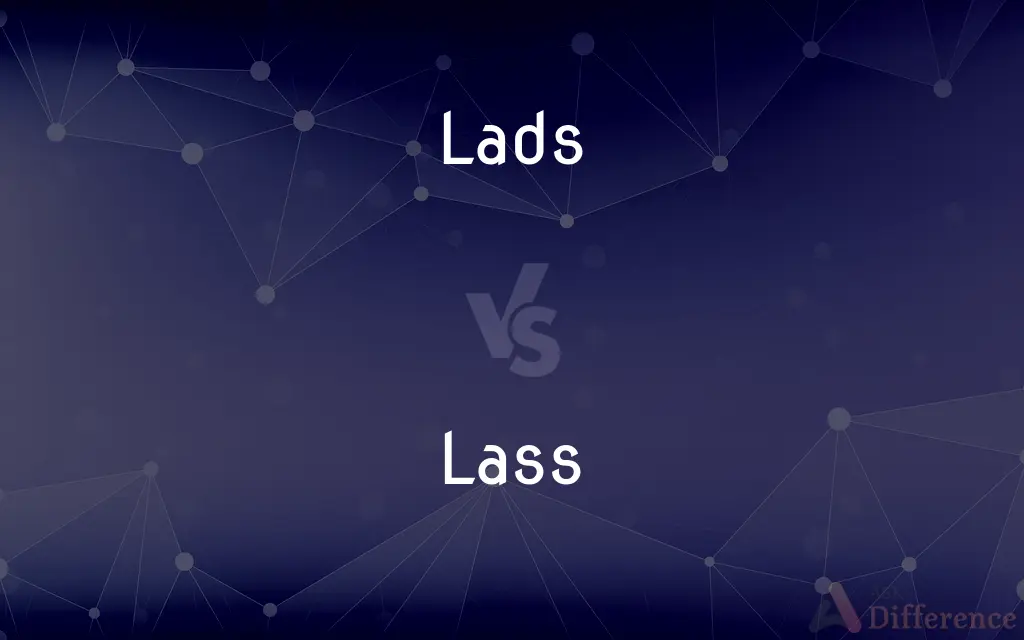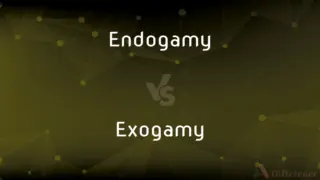Lads vs. Lass — What's the Difference?
Edited by Tayyaba Rehman — By Fiza Rafique — Updated on April 2, 2024
Lads typically refers to young men or boys, often conveying a sense of camaraderie or youthfulness, while lass is used to denote a young woman or girl, carrying a tone of affection or informality.

Difference Between Lads and Lass
Table of Contents
ADVERTISEMENT
Key Differences
Lads and lass are terms steeped in cultural and linguistic tradition, each referring to young individuals but differentiated by gender. "Lads" is commonly used to refer to young men or boys, often carrying connotations of youthfulness, camaraderie, and sometimes mischief. On the other hand, "lass" denotes a young woman or girl, and it often carries with it a tone of endearment and informality. These terms reflect social interactions and cultural perceptions of gender and age.
The use of "lads" can be found in various contexts, from casual conversations among friends to literature, where it might evoke a sense of brotherhood or collective identity among young men. It's often used to address or refer to groups in a light-hearted, informal manner. Conversely, "lass" is similarly used in informal settings but emphasizes the youth and often the charm or sweetness of a young woman. This distinction in usage highlights the nuanced ways in which language mirrors social and cultural attitudes towards gender.
In some regions and dialects, "lads" and "lass" carry strong cultural identities, particularly in parts of the UK and Ireland, where they are deeply ingrained in the vernacular. Here, "lads" might be used to refer to male friends or peers in a collective sense, while "lass" would be used in a parallel manner for females. The terms are rich in cultural significance, often evoking a sense of belonging and regional identity.
While both terms are affectionate and informal, the contexts in which they are used can reveal attitudes towards gender roles and expectations. For example, "lads" might be used in scenarios that underscore traditional male bonding or activities, whereas "lass" could be employed in ways that highlight femininity or the perceived attributes of young women. This distinction, though subtle, underscores how language can both reflect and perpetuate cultural norms.
Despite their traditional roots, the usage of "lads" and "lass" in contemporary language continues to evolve, with both terms being embraced, redefined, or even contested in different contexts. As societies become more aware of and sensitive to gender nuances, the use of such gender-specific terms may shift to reflect changing attitudes, though they still hold a place in capturing the essence of youth and gender in a culturally rich manner.
ADVERTISEMENT
Comparison Chart
Definition
Refers to young men or boys, often with connotations of camaraderie.
Denotes a young woman or girl, carrying tones of affection and informality.
Connotations
Youthfulness, brotherhood, mischief.
Youth, charm, sweetness.
Cultural Significance
Strong in regions like the UK and Ireland, associated with male identity.
Similarly culturally significant, often emphasizing femininity and regional identity.
Usage Context
Casual, often in groups, reflecting male bonding.
Informal, individual or groups, highlighting perceived feminine attributes.
Evolution
Usage evolves with societal attitudes towards masculinity and camaraderie.
Reflects changing perspectives on femininity and informality in language.
Compare with Definitions
Lads
Young men or boys, often implying youthful energy or brotherhood.
The lads gathered for a game of football in the park.
Lass
Refers to a young woman or girl, often with an affectionate tone.
The young lass was admired for her kindness in the village.
Lads
Can imply mischief or adventurous spirit among young men.
The lads were known for their harmless pranks in the community.
Lass
Signifies informality and endearment when referring to young women.
That lass has a voice like an angel, the locals would say.
Lads
Informal, often used affectionately to refer to male friends or peers.
He's one of the lads; he's always there when you need him.
Lass
Used informally, capturing the essence of youth and femininity.
She's not just any lass; she's someone with dreams as big as the sky.
Lads
Used among male friends to denote camaraderie or group identity.
The lads from the neighborhood are planning a road trip together.
Lass
Has strong roots in Scottish and Northern English dialects, reflecting cultural identity.
At the festival, every lass wore traditional attire, celebrating their heritage.
Lads
Particularly prevalent in British and Irish contexts, where it denotes male youth culture.a
In many British pubs, groups of lads can be seen enjoying a night out.
Lass
Emphasizes youth and often a sense of innocence or charm.
The lass next door is always helping her family with a smile.
Lads
A boy or young man.
Lass
A girl or young woman
He married a lass from Yorkshire
Village lasses
Lads
(Informal) A man of any age; a fellow.
Lass
A girl or young woman.
Lads
Plural of lad
Lass
A sweetheart.
Lads
A group of friends, regardless of gender. Often the lads.
Lass
A young woman or girl.
Come and dance, ye lads and lasses!
Lass
A sweetheart.
Lass
A young woman; a girl; a sweetheart.
Lass
A girl or young woman who is unmarried
Common Curiosities
Do "lads" and "lass" imply any specific age range?
While not strictly defined, they generally refer to the youth or younger individuals, often teenagers or those in their early twenties.
Is it common to use "lads" and "lass" outside of the UK or Ireland?
While most associated with these regions, globalization and cultural exchange have broadened their use, making them recognizable, albeit less common, in other English-speaking areas.
Can "lads" and "lass" be used in formal contexts?
Typically, both terms are reserved for informal contexts due to their casual and affectionate connotations.
What is the origin of "lads" and "lass"?
Both terms have roots in Old English, with "lads" originating from "lad" (young man) and "lass" from "las" (young woman), reflecting historical gender distinctions.
In what types of literature or media are "lads" and "lass" commonly found?
These terms are often found in folk literature, songs, and regional narratives, especially those set in or inspired by cultures where the terms are part of the vernacular, such as British or Irish settings.
How do "lads" and "lass" reflect cultural identity in the regions where they are used?
They embody and convey regional cultural identities, reflecting local dialects, traditions, and social norms that are unique to certain areas, particularly within the UK and Ireland.
Can "lads" and "lass" be used affectionately towards older individuals?
While primarily associated with youth, they can be used affectionately towards older individuals, often to evoke a sense of youthfulness or fondness.
Are "lads" and "lass" considered gender-neutral terms?
No, "lads" specifically refers to young men, and "lass" to young women, making them gender-specific terms rooted in traditional gender distinctions.
Do "lads" and "lass" have equivalents in other languages?
Yes, many languages have their own equivalents to denote young men and women, often carrying similar connotations of youth, camaraderie for males, and affection or charm for females.
How have the uses of "lads" and "lass" evolved over time?
While retaining their original meanings, contemporary use has seen them embraced in more diverse contexts, reflecting broader and sometimes more inclusive cultural identities.
In what contexts might using "lads" and "lass" be seen as outdated or inappropriate?
In highly formal or professional settings, or in regions where the terms are not commonly used, they might be seen as outdated or too informal. Additionally, sensitivity to gendered language might make their use inappropriate in some contemporary contexts.
Can "lads" and "lass" be empowering terms?
Depending on the context and how they are used, these terms can be empowering, evoking a sense of belonging, pride, or affection. However, their impact greatly depends on the speaker's intent and the listener's perception.
How do social media and global communication affect the usage of "lads" and "lass"?
Social media and global communication platforms have increased the exposure and usage of regional terms like "lads" and "lass," often leading to their adoption in new contexts and among broader audiences outside their traditional regions.
Is there a modern equivalent to "lads" and "lass" in contemporary slang?
Modern slang continues to evolve, with terms like "guys" for mixed or same-gender groups and "gals" or "girls" for females being more commonly used in casual, contemporary speech across various English-speaking regions.
How does the use of "lads" and "lass" in media and entertainment influence perceptions of these terms?
Their depiction in media and entertainment can reinforce traditional connotations, introduce them to new audiences, and potentially shape contemporary understandings and uses of the terms, often reflecting or challenging existing gender norms.
Share Your Discovery

Previous Comparison
Isothermic vs. Isothermal
Next Comparison
Endogamy vs. ExogamyAuthor Spotlight
Written by
Fiza RafiqueFiza Rafique is a skilled content writer at AskDifference.com, where she meticulously refines and enhances written pieces. Drawing from her vast editorial expertise, Fiza ensures clarity, accuracy, and precision in every article. Passionate about language, she continually seeks to elevate the quality of content for readers worldwide.
Edited by
Tayyaba RehmanTayyaba Rehman is a distinguished writer, currently serving as a primary contributor to askdifference.com. As a researcher in semantics and etymology, Tayyaba's passion for the complexity of languages and their distinctions has found a perfect home on the platform. Tayyaba delves into the intricacies of language, distinguishing between commonly confused words and phrases, thereby providing clarity for readers worldwide.














































